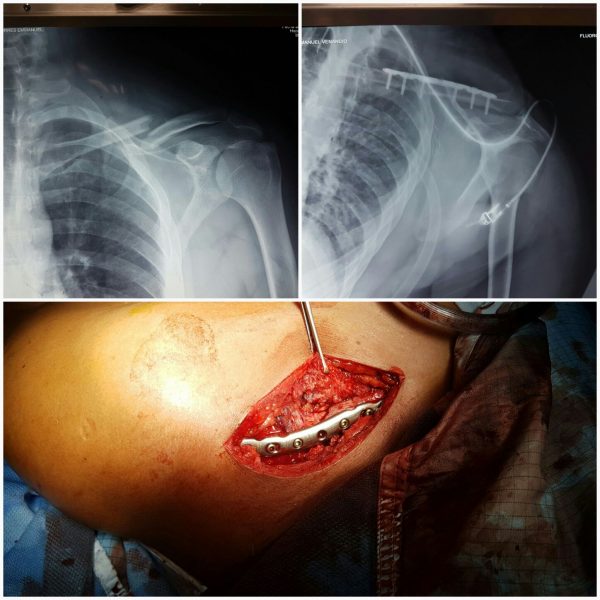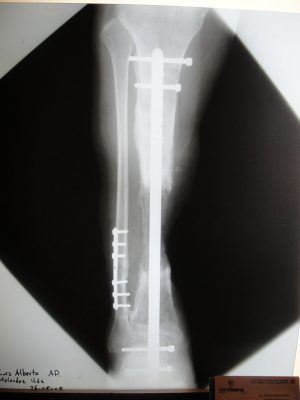BONE FRACTURE AND IT'S COMPLICATIONS

Fracture management can be divided into nonoperative and operative techniques, both of them have the main goal to restore it´s regular function.
If the right operative treatment is not done some complications can appear, such as: pseudoarthrosis, bone deformities, bone shortenings and lost bone.
In our Orthopaedic Specialist Center we have a full and wide experience in the treatment of all these cases such as the regular bone fracture as in it´s complications.
Pseudoarthrosis, Bone Deformitie and Bone Infection

After a bone fracture we have to plan a full reconstruction including it´s complications. If the fracture gets an infection, first we have to start on IV antibiotics and surgical removal of the infected tissue (as many times as needed), ending with oral antibiotics.

Pseudoarthrosis is a lack of healing bone, commonly referred as a false joint; it´s divided in to:
a) Atrophic or Avascular without deformities. For it´s treatment we required an orthopaedic intraosseus osteosynthesis material plus an autologous bone trasnplant or from the bone bank. If a deformitie exists, then we have to treat it.
b) Hypertrophic. In this cases we have to stabilize with an orthopaedic implant, and in case of a bone deformitie it has to be solve in a short or long term.
Can be associated with:
a) Bone loss. In this particular cases an external fixation has to be used, an osteotomy has to be permormed and a lenghtening of 1 mm per day has to be donde until both bones get together.
One of the most common complications derivated from the cause of the bone fracture or from the surgical treatment is an Osteomyelitis (bone infection); if this is associated with a bone continuity a surgical treatment 1 or even 3 times are required, length of stay between 4 or 7 days, IV and oral antibiotics are needed for several weeks
a) Atrophic or Avascular without deformities. For it´s treatment we required an orthopaedic intraosseus osteosynthesis material plus an autologous bone trasnplant or from the bone bank. If a deformitie exists, then we have to treat it.
b) Hypertrophic. In this cases we have to stabilize with an orthopaedic implant, and in case of a bone deformitie it has to be solve in a short or long term.
Can be associated with:
a) Bone loss. In this particular cases an external fixation has to be used, an osteotomy has to be permormed and a lenghtening of 1 mm per day has to be donde until both bones get together.
One of the most common complications derivated from the cause of the bone fracture or from the surgical treatment is an Osteomyelitis (bone infection); if this is associated with a bone continuity a surgical treatment 1 or even 3 times are required, length of stay between 4 or 7 days, IV and oral antibiotics are needed for several weeks
How it´s done?
In order for treating this complications froma broken bone it´s necessary to perform a detail preoperatory planification.
Inside this routine a careful physcialexploration has to be performed to find if the patient has: any functional damage to the joint; muscular, neurological and vascular integrity in the affected limb and the rest of the body.
A multidisciplinary group is needed, besides the orthopedist an infectologist, a plastic surgery, a physiatrists, a bone metabolic specialist or any other doctor that could be needed at any time should be part of the treatment. All of these will aloud the the patient, family and the orthopedist to become with the right treatment, knowing the benefits and risks alla the time of the procedure to perform.
Inside this routine a careful physcialexploration has to be performed to find if the patient has: any functional damage to the joint; muscular, neurological and vascular integrity in the affected limb and the rest of the body.
A multidisciplinary group is needed, besides the orthopedist an infectologist, a plastic surgery, a physiatrists, a bone metabolic specialist or any other doctor that could be needed at any time should be part of the treatment. All of these will aloud the the patient, family and the orthopedist to become with the right treatment, knowing the benefits and risks alla the time of the procedure to perform.
Diagnosis
At the medical history it´s important to know if there is any type of illness that could modify the orthopaedical treatment potentialy; photos from the upper and lower limbs; a video of the regular movements and type of walking of the affected limb.Imaging studies are necessary:
X ray from the affected area (in which should appear proximal and distal joint) and also a panoramic one shoul be included.
CT scan, MRI and bone scan are also needed.
Bone densitometry and electromyography are also needed.
Blood test is required to know the basic metebolism of the patient.
And if the infection is already there, a culture of bacteria from the affected área will be needed.
